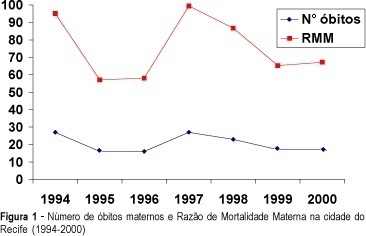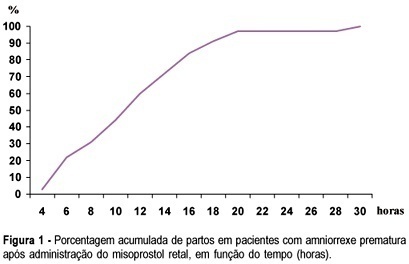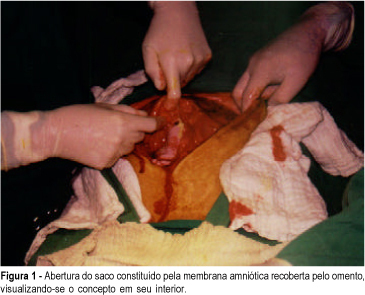You searched for:"Melania Maria Ramos de Amorim"
We found (25) results for your search.Summary
Rev Bras Ginecol Obstet. 2003;25(1):45-52
DOI 10.1590/S0100-72032003000100007
PURPOSE: to determine maternal and neonatal outcome according to the application or not of transcutaneous electrical nerve stimulation (TENS) for relief of labor pain before installation of combined spinal epidural (CSE) block. METHODS: a randomized open clinical trial was conducted involving 22 parturients with a singleton, vertex, term fetus, managed in a tertiary-care academic medical center in Recife, Brazil. These patients were randomly assigned to receive or not TENS before CSE block for labor analgesia. Outcome analysis included pain intensity as measured by visual analog scale (VAS), interval between initial evaluation and CSE installation, labor duration, cesarian section and instrumental delivery rate, Apgar scores and frequency of neonatal hypoxia. Statistical analysis was performed using Mann-Whitney and Fisher's exact tests with a 5% level of significance. RESULTS: a significantly prolonged interval between initial evaluation and CSE block was observed in the TENS group (median of 90 min) when compared with the control group (median of 30 min). Duration of labor was similar (about 6 h). No significant difference was found in VAS scores. Cesarian section rate was 18.2% in both groups. There was only one forceps delivery (in the control group). The median of Apgar scores at the 5th minute was 10 and no case of neonatal hypoxia was found. CONCLUSONS: TENS was effective in delaying CSE analgesia installation without affecting pain intensity and duration of labor. There were no adverse effects on mothers or newborns.
Summary
Rev Bras Ginecol Obstet. 2002;24(7):455-462
DOI 10.1590/S0100-72032002000700005
Purpose: to determine the Maternal Mortality Ratio (MMR) among women living in the city of Recife, Brazil through the analysis of all death certificates of women aged 10-49 years from 1994 to 2000. To determine the underreporting rate and to study the main characteristics, basic causes, classification and avoidance of maternal deaths. Methods: a descriptive population-based study was conducted and all death certificates of women aged 10-49 years were analyzed and classified as declared or presumed (Laurenti criteria). Clinical records and autopsy data, when available, were studied and basic cause and underreporting rate were determined. Maternal Mortality Ratio was calculated using information on live births from SINASC ("Sistema de Informações dos Nascidos Vivos"). Results: a total of 144 maternal deaths were identified (declared=104; presumed and confirmed after investigation=44). The Maternal Mortality Ratio was 75.5 per 100,000 live births. The underreporting rate was 27.8%. A predominance of direct causes was observed (about 69%) and the most frequent causes of death were hypertension (19%), hemorrhage (16%) and infection (11%). About 82% of the deaths were considered avoidable by adequate antenatal, delivery and post-partum care. Conclusions: Maternal Mortality Ratio is high in the city of Recife, Brazil and the underreporting rate is still high. Direct obstetric causes and avoidable deaths are predominant. There is a lack of adequate antenatal, delivery and post-partum care.

Summary
Rev Bras Ginecol Obstet. 2008;30(9):459-465
DOI 10.1590/S0100-72032008000900006
PURPOSE: to evaluate the effect of maternal, socioeconomic and obstetric variables, as well the presence of artery incisions in the 20th and 24th weeks on the fetal weight estimated at the end of pregnancy (36th week) in pregnant women attended by Programa Saúde da Família, in an inland town of the northeast of Brazil. METHODS: a longitudinal study including 137 pregnant women, who have been followed up every four weeks in order to assess clinical, socioeconomic and obstetric conditions, including their weight. The uterine arteries were evaluated by Doppler in the 20th and 24th weeks, the fetal weight and the amniotic fluid index (AFI), determined in the 36th week. The initial maternal nutritional state has been determined by the body mass index (BMI), the pregnant women being classified as low weight, eutrophic, over weight and obese. Weight gain during gestation has been evaluated, according to the initial nutritional state, being classified at the end of the second and third trimester as insufficient, adequate and excessive weight gain. Analysis of variance was performed to evaluate the association of the fetal weight in the 36th week with the predictor variables, adjusted by multiple linear regression. RESULTS: an association between the fetal weight estimated in the 36th week and the mother's age (p=0.02), mother's job (p=0.02), initial nutritional state (p=0.04), weight gain in the second trimester (p=0.01), presence of incisions in the uterine arteries (p=0.02), and AFI (p=0.007) has been observed. The main factors associated to the fetal weight estimated in the 36th week, after the multiple regression analysis were: BMI at the pregnancy onset, weight gain in the second trimester, AFI and tabagism. CONCLUSIONS: in the present study, the fetal weight is positively associated with the initial maternal nutritional state, the weight gain in the second trimester and the volume of amniotic fluid, and negatively, to tabagism.
Summary
Rev Bras Ginecol Obstet. 2003;25(7):491-499
DOI 10.1590/S0100-72032003000700005
PURPOSE: to investigate whether rectally administered misoprostol is an effective method for induction of labor in patients with premature ruptured membranes at term. METHODS: a pilot trial was conducted, enrolling 32 women with alive, singleton, cephalic fetus and ruptured membranes between 36 and 41 weeks of pregnancy, with Bishop score <6 and without evidence of labor. They received rectal misoprostol (tablets of 50 mg) every 4 h until active labor was diagnosed. Patients with ruptured membranes for >18 h received antibiotics (crystalline penicillin) for prophylaxis of streptococcal infeccion. Outcomes included time from induction to labor and induction to delivery, incidence of tachysystole, mode of delivery, incidence of chorioamnionitis and neonatal outcome. Statistical analysis was performed using the public domain software Epi-Info 2002. Means and standard deviations were calculated, as well as frequency distributions. Survival analysis was performed to determine percent of deliveries according to time (hours) since the administration of the first tablet. RESULTS: the mean (±SD) induction-to-labor and induction-to-delivery intervals were 299.8±199.9 and 681±340.5 min, respectively. The frequency of tachysystole was 9.4%. About 72% of patients achieved vaginal delivery. Chorioamnionitis was diagnosed in 12.5% of the patients. Median Apgar scores at 1st and 5th min were 8 and 9, respectively. There was no case of Apgar <7 at the 5th min. Neonatal sepsis occurred in 12.5% of the neonates. CONCLUSION: induction of labor with rectal misoprostol in the setting of premature rupture of membranes was effective, with 72% of vaginal deliveries and a low rate of chorioamnionitis. These findings must be confirmed by large randomized controlled trials.

Summary
Rev Bras Ginecol Obstet. 1999;21(10):611-615
DOI 10.1590/S0100-72031999001000009
Term abdominal pregnancy with live fetus is an obstetrical rarity with high fetal and maternal morbidity and mortality. The authors present a case of abdominal pregnancy in a 43-year-old woman. The diagnosis was made only at term (37 weeks) by clinical findings and echography. Exploratory laparotomy was performed and a living female newborn weighing 2,570 g was extracted. Apgar scores were 3, 6 and 8 at the 1st, 5th and 10th minutes, respectively. Placenta was inserted in the omentum and was removed without complications. Postoperative course was uneventful and both mother and child were discharged healthy.

Summary
Rev Bras Ginecol Obstet. 2002;24(10):655-661
DOI 10.1590/S0100-72032002001000004
PURPOSE: to evaluate the effects of antenatal corticosteroid treatment on the incidence of respiratory distress syndrome (RDS), neonatal morbidities, and mortality in preterm babies assisted at IMIP, a teaching hospital in Brazil. METHODS: this was an observational, analytical, cohort study which included 155 newborns from women who delivered prematurely. The study was conducted between February and November 2001 and included 78 women in the corticosteroid-treated group and 77 in the nontreated group. The study design included the incidence of RDS, assessment of morbidities related to prematurity and tabulation of neonatal mortality. The risk ratio and its 95% confidence interval were determined for estimation of the relative risk for RDS and neonatal outcome (dependent variables) according to antenatal corticoid therapy administration (independent variable). RESULTS: corticosteroid treatment was administered to 50.3% of the patients (64% of the women received the full treatment course, while 36% of the same group received a partial course of treatment). The incidence of RDS was significantly lower in the corticosteroid treated group (37.2%) compared with the nontreated group (63.6%). There was no observable decrease in the risk for morbidities associated with prematurity. There was a decrease in mortality and in the frequency of supplemental oxygen therapy in the corticosteroid group (37%). On multiple logical regression analysis, there was a 72% reduction in the risk for RDS in the corticosteroid group, and approximately a seven times greater risk for RDS in babies of gestational age below 32 weeks. CONCLUSIONS: a favorable impact of antenatal corticosteroid administration was observed, with significant reduction of the risk for RDS in patients with gestational age between 26 and 35 weeks. Although no effect on the other morbidities was observed, this can be explained by the small size of the sample.
Summary
Rev Bras Ginecol Obstet. 2008;30(2):80-86
DOI 10.1590/S0100-72032008000200006
PURPOSE: to describe the clinical and laboratorial profile of HELLP syndrome patients admitted at an Obstetric Intensive Care Unit (ICU) and included in a randomized clinical trial to evaluate the efficacy of dexamethasone in this clinical setting. METHODS: the present study is a secondary analysis of a randomized clinical trial design to evaluate the efficacy of dexamethasone in patients with HELLP syndrome. This sample of patients was composed of patients in the puerperium, with the diagnosis of HELLP syndrome (diagnosis made before or after delivery) who were not chronic corticosteroid users and not carriers of any chronic disease which could modify HELLP syndrome's laboratorial parameters. Patients who were too critical or whose condition did not allow them to consent to participate were not included. Data were extracted from the records used in the randomized clinical trial. Age, parity, gestational age at admission and delivery, time of diagnosis (before or after delivery), HELLP syndrome classification (partial or complete), arterial blood pressure, and diuresis at admission were considered for analysis. Among laboratorial findings, hemoglobin, platelet count, liver enzymes, LDH, and serum bilirubin were analyzed. Complications presented by the patients were also analyzed as well as need of blood transfusions and duration of hospitalization. Analysis was made by the Epi-Info 3.3.2 program. RESULTS: one hundred and five patients were analyzed. Age varied from 14 to 49 years (means of 26.7). Regarding parity, 56 patients (53.8%) were primiparas. Analyzing the timing of the diagnosis, 47 patients (45.2%) had the diagnosis before delivery. The mean gestational age in these patients was 32.4 weeks. Hemorrhagic manifestations were observed in 36 patients (34.3%), oliguria was present in 49 patients (46.7%) and criteria for acute renal failure were seen in 21 (20%) of the cases. Hemotransfusions were necessary in 35 (33.3%) patients. Seven patients (6.7%) had pulmonary edema and four patients died, corresponding to 3.8% of the cases. The mean time from diagnosis of HELLP syndrome to discharge or death was 10.3 days, varying from 1 to 33 days. CONCLUSIONS: HELLP syndrome is an ominous diagnosis, which implicates in elevated maternal morbimortality. Among complications, oliguria and hemorrhagic manifestations were the most common findings and hemotransfusions were frequently required. Lethality reached 3.8%.

Summary
Rev Bras Ginecol Obstet. 2010;32(2):82-87
DOI 10.1590/S0100-72032010000200006
PURPOSE: to study the clinical and microbiological profile of women with bacterial vaginosis participating in a randomized, double-blind clinical trial, which compared the vaginal use of preparations from red pepper tree and metronidazole for the treatment of genital discharge. METHODS: the study was conducted on a series of 277 women with bacterial vaginosis concomitantly diagnosed by the criteria of Amsel and Nugent, selected from a total of 462 recruited patients using the information obtained before intervention. Data were analyzed with the Epi-Info 3.32 software. In order to compare the outcomes frequencies between the intervention groups, the χ2 test was used and the risk ratio and 95% confidence interval were calculated. The intention to treat analysis was performed. In addition to the determination of diagnostic parameters, the culture of vaginal content and a Papanicolaou cytology test were also performed. RESULTS: the most frequent clinical complaints were genital discharge, observed in 206 participants (74.4%) and the fish odor of the vaginal secretion, which occurred in 68.6% of the cases (190 patients). Among the diagnostic clinical criteria, the presence of clue-cells was positive in 275 women (99.3%), the Whiff test, in 266 (96.0%), followed by pH >4.5, which occurred in 92.8% of the cases, and by the presence of fluid grayish discharge reported by 206 participants (74.4%). Regarding the Nugent criterion, the median score was 8.0. Culture of the vaginal content permitted the identification of Gardnerella vaginalis in 96.8% of cases and of Mobiluncus in 53.1%. Only one third of the exams showed the presence of Lactobacillus (89 women - 32.1%). Fungal growth occurred in the cultures of 14 participants (5.1%). In most cases, culture revealed the presence of Corynebacterium (94.2%), Gram-positive cocci (98.2%), as well as Gram-positive (99.3%) and Gram-negative (91.0%) bacilli. Oncotic colposcopy revealed a very scarce presence of lactobacilli, which were present in only 8 cytological exams (2.9%) out of the total of 273 exams performed. CONCLUSIONS: the results of the present study did not differ from the literature regarding the symptoms reported by the women, the clinical criteria most frequently observed in the diagnosis, or the bacterial species detected in cultures of vaginal content. These findings indicate the need for further studies that might better elucidate the interrelations between the microbiological findings and the clinical expression of bacterial vaginosis.